Soil is the foundation for healthy grass. Most homes come with less than ideal soils. Improving your soil is the number one thing you can do to improve your lawn. It doesn’t matter whether you start with sandy loose soil or you have heavy clay soil you can improve either case by adding soil amendments.
A soil amendment or soil conditioner is a product which is added to soil to improve its physical qualities, usually its fertility (ability to provide nutrition for plants) and sometimes its mechanics (fluids and particles). Not only can most soils be improved, they usually need to be improved to get the maximum results. Soil amendments can be used to improve poor soils, or to rebuild soils which have been damaged by improper soil management. They can make poor soils more usable, and can be used to maintain soils in peak condition.

If your lawn is already established, improving soil quality is more challenging than if you are growing a new lawn. To boost the health and appearance of an existing lawn, follow these tips on how to improve soil quality. This article will explain the different soil types and the amendments you can add to improve the structure, drainage and moisture retention of your soil.
Purpose of Soil
To better understand what we’re dealing with its helpful to remember what purpose soil serves. Soil has four important functions:
- as a medium for plant growth;
- as a means of water storage, supply and purification;
- as a modifier of the Earth’s atmosphere; and
- as a habitat for organisms
In the natural environment, all of these functions, in their turn, modify the soil.
Purpose of Soil Amendments
To help nature along, as long as we exercise diligence, we can intervene in this process to help the soil support healthy, vigorous plant growth. We do this by using soil amendments to improve the soil’s physical qualities, usually its fertility and sometimes its mechanics. Soil amendments are most commonly used to improve soil structure, nutrients, and water retention.
Soil structure
The most common use of soil amendments is to improve soil structure. Soils tend to become compacted over time. Soil compaction impedes root growth, decreasing the ability of plants to take up nutrients and water. Soil amendments can add more loft and texture to keep the soil loose.
Soil nutrients
For centuries people have been adding things to poor soils to improve their ability to support healthy plant growth. Some of these materials, such as compost, clay and peat, are still used extensively today. Many soil amendments also add nutrients such as carbon and nitrogen, as well as beneficial bacteria. Additional nutrients, such as calcium, magnesium and phosphorus, may be augmented by amendments as well. This enriches the soil, allowing plants to grow bigger and stronger.
Water retention
Soil amendments may be used to improve water retention in dry, coarse soils which are not holding water well. The addition of organic material for instance can greatly improve the water retention abilities of sandy soils and they can be added to adjust the pH of the soil to meet the needs of specific plants or to make highly acidic or alkaline soils more usable.
Soil Composition
Soils come in many varieties and ensuring that you have the best possible blend will improve the quality of your lawn. Soil is typically categorized by a combination of its physical properties (texture, structure, density, etc), its composition and its chemistry (nutrient exchange capacity and pH). This article will focus on the main elements that effect lawn growth.
Soil is composed of a mixture of organic matter (the non-mineral component of soil), minerals (mainly sand, silt, and clay), gases (mainly air), liquids (mainly water), and organisms that together support life. For a typical healthy soil 50% is composed of air and water, 45% minerals, and just 5% organic matter.
Soil Texture
Soil texture describes the percentages of sand, silt, and clay in the soil. Size, shape and amount of each in the soil influences drainage, moisture and nutrient holding ability. A soils texture can be used to determine grass type suitability and to predict the response of the soil to environmental and management conditions such as drought or nutrient requirements. A soils texture determines many of the properties of the soil, in particular how it retains or disperses water. Of these minerals clay is the smallest particle and sand is the largest – and this largely dictates how they react with water.
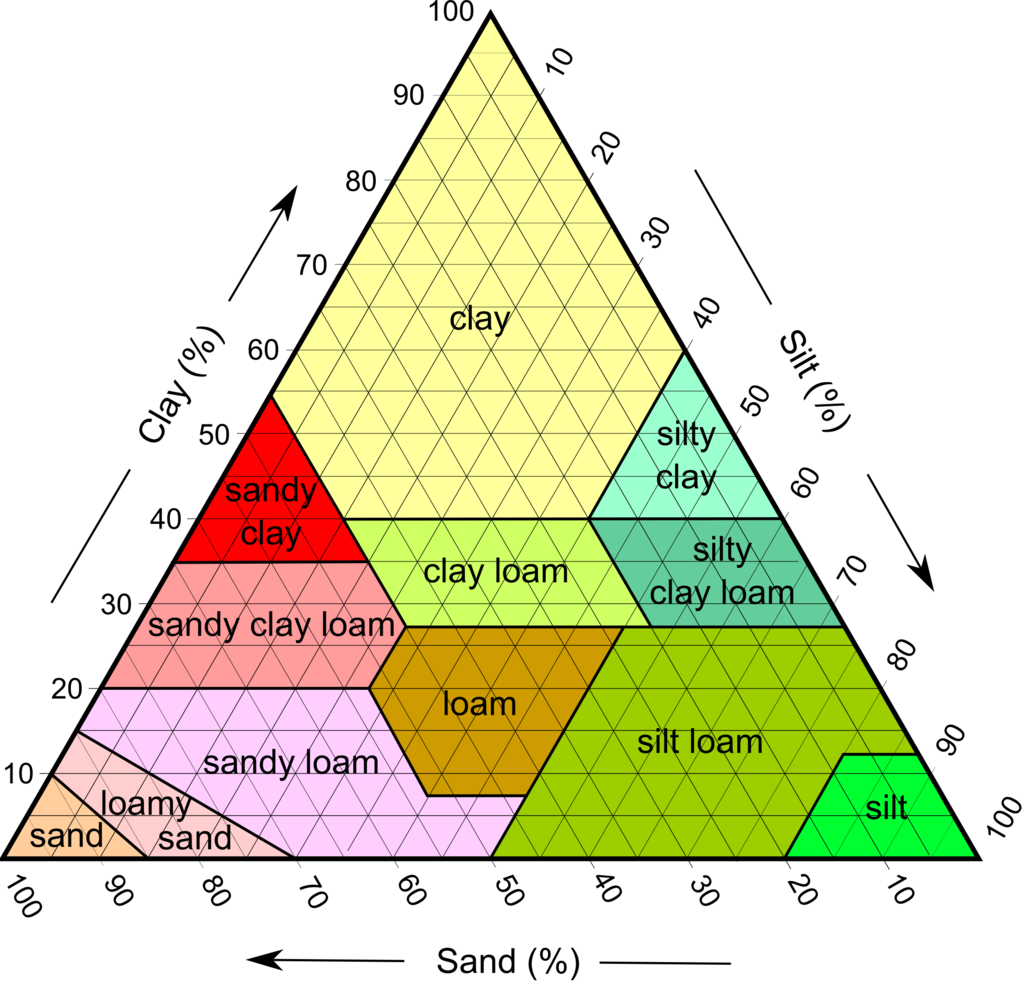
High Clay Soil
A high clay soil holds on to nutrients, stays wet longer, and is slow to warm up and dry off in spring. These soils are slimey and can be formed in your hand when wet. Avoid working high clay soils when wet – this leads to compaction. Clay soils are made of extremely small particles that are packed close together. When lawns growing on clay soils receive even moderate foot traffic, the particles mash together in what is known as compaction. There is little room for water and air, because the voids are reduced. The limited space tends to fill up with water after a rainfall, leaving little or no oxygen for the root system. Water does not pass quickly through clay soils, and often will move downward only after the soil voids are completely saturated. The roots remain wet, and are vulnerable to rot.
Clay soils do have their advantages. They hold water well, reducing the loss of nutrients through runoff. Lawns growing in soils predominant in clay can be fertilized and watered less often, due to their holding capacity.
High Sand Soil
Soils with a high composition of sand barely hold together and feel gritty. The larger particles create pores for water and nutirents to move through quickly. They tend to be nutirent deficient, fast draining and dry. High sand soils will need watering and fertilizing more often. But they warm up and dry quickly in the spring. Sandy soils are very well drained, and sometimes excessively so. The angular shape of the particles creates lots of air space so that water passes through the soil quickly. In general, roots thrive in sandy soils, because they get the oxygen they need to grow well. Another advantage is that sandy soils hold their shape well, and resist compaction. This is very important in high-traffic areas. Golf course greens and professional sports fields are heavily sand based. They require compaction resistance and rapid drainage to maintain a firm, safe playing surface.
The down side to a predominantly sandy soils is that they will not hold water and nutrients well. Moisture tends to flow right through these soils, making it necessary to water frequently. And because sand particles are slick and hard, much like marbles, they have few sites for holding on to nutrients and fertilizing must be done frequently. Sandy soils are managed best by applying light but frequent doses of water and nutrients, and they can be improved by adding components that hold water and nutrients well, such as compost or aged manure. (Fech)
Silty Soils
Silty soils fall somewhere in-between. Silt particles are smaller than those of sand and not much larger than clay particles. Silty soils perform much like clay soils. Their particles tend to stick together, and they are prone to compaction. In some parts of the country, they are referred to as “muck” soils. They hold nutrients well, and most are naturally plentiful in soil nutrients, reducing the need for the homeowner to fertilize the lawn.
Loam
In its ideal combination, soil is known as loam, a mixture of roughly 20% clay, 40% silt, and 40% sand. Loam encourages nutrient retention and proper drainage. You may have to add certain amendments to your soil to bring it nearer to this ratio.
Soil Profile
Equally important to soil texture is the soil profile.

Soils typically have an organic surface layer, a surface or top soil, subsoil, and end at bedrock. The organic surface layer consists of plant residues, with the upper part often relatively undecomposed. The surface or top soil is the layer of mineral soil with the most organic matter accumulation and soil life. The subsoil layer has normally less organic matter and its colour is mainly derived from iron oxides.
Abrupt differences between soil layers can prevent water from freely percolating into the ground. The most common example is a predominantly clay layer over a predominantly sandy soil. Clay has much smaller and more numerous voids that must be filled with water before it will percolate down. This limits the depth of the root zone to the upper layer. The upper layer is also prone to compaction, and there may be standing water on the lawn for several hours after a rainfall.
To determine your soil profile the easiest way is to use a soil profile tool. Here is mine on the left. They can be found for about $50 on Amazon.

Infiltration testing
The soil beneath the lawn must be able to handle the water that falls on the yard as precipitation and when watering, or the resulting pools of water may cause the roots to rot. On slopes, the water may run off, resulting in dry soils where the grass suffers from drought stress. The infiltration rate (the speed at which water moves downward) is affected by several factors, especially soil particle size and the relative position of soil layers.
If you suspect your yard may absorb water too slowly, you can perform a simple soil infiltration test.
Knowing your lawn’s capacity to accept rainfall will suggest how often to water, and how long to water each time. For example, if the water is absorbed quickly, you know that your soil should be watered more frequently and with less volume.
Perched Water Table
If your lawn continually has standing water, or if the roots are commonly rotten upon inspection you may have a perched water table. This is when there is a water table above a layer of low permeability material such as clay This is very difficult to correct The only real solution is to rebuild the soil, so that the topsoil, subsoil, and bedrock are in the proper location and proportion. You can go through the work of stripping off the sod for reuse, then changing the soil’s composition.

The process is expensive and quite laborious. Soil rebuilt to a depth of of 24 inches is ideal, but you may only be able to enhance the upper 12 to 18 iches or so. Use a rented front-end loader for this operation or hire a contractor to do the job.
If you choose not to go with a full rebuilding you can prevent root rot and problems with standing water by watering more often and putting on less water with each application.
What is the Best Soil for Grass?
Ideal soils for lawns have a loose structure to allow water, air, and nutrients to penetrate through them. Soil that contains too much clay will pack down, making it difficult for the plants to spread their roots and access much-needed moisture. Soil that contains too much sand becomes very loose and allows too much water to flow through, without allowing the plants time to absorb the moisture. Ideal soil contains organic matter known as humus. Humus is made up of the remains of decaying organisms and is packed with natural nutrients that not only help give soil a good crumbly or friable structure, but also act as a natural fertilizer for plants. Unlike manufactured fertilizers, organic matter releases nutrients slowly into the soil, keep it nourished for long periods of time. A good lawn soil also includes an element that aids with moisture retention and keeps the plants well hydrated.
The ideal soil mineral composition for most turf grass consists of about 70% sand, 15% clay and 15% silt.
Common Types of Soil Amendments
A wide variety of materials have been described as soil amendments due to their ability to improve soil quality. Some examples include biochar, bone meal, blood meal, coffee grounds, compost, compost tea, manure, liquified seaweed, straw, peat, sphagnum moss, vermiculite, sulfur, lime, humic acid, and biosolids. Many soil amendments come in the form of certified organic products. Soil amendments of almost every description are readily available from online stores, nurseries as well as garden supply stores.
I will touch on a few of these here. I will add more to this article in the future.
Organic matter: Arguably the most important type of soil amendment is organic matter, even though it only makes up 3 to 5% of a good soil’s composition. And it is one of the most common soil deficiencies, either because the soil was initially poor or because it was degraded in the construction process. Organic matter content will gradually improve with the age of a lawn, but it is a very slow process–even a 30-year-old home may have a yard deficient in this component.
Adding organic matter will help your soil retain more moisture while still allowing it to drain and it will improve the structure and texture and add those all important micro-organisms to help your lawn thrive.
Substances such as finished compost, well-rotted leaves and other natural materials, worked down into soil, improve the way soil particles fit together and the way air and water move through them. Organic matter improves the soil’s capacity for holding water and nutrients, and increases the activity of beneficial microorganisms. Earthworm castings amends soil with organic matter and benefits your plants in many other ways.
This nutrient-rich material serves to moderate the hardness of the mineral component. When the soil is predominantly clay or sand, the addition of organic matter (aged manure, Canadian peat moss, ground bark, sawdust, compost) makes clay soil looser, and easier to work. In clay soils, organic matter additions improve drainage, and allow air to move into the soil more readily. In sandy soil, it helps to hold moisture and nutrients in the root zone of the lawn. Organic matter has the magical quality of being able to help both soil problems. If you want to know what it looks like, buy a bag of compost at a garden center. High-quality composts are predominantly organic matter.
A soil test may reveal your yard has no more than 1 to 1.5 percent organic matter, when the ideal range is 3 to 5. To improve a serious shortfall before putting in a lawn, add liberal amounts of finished compost to your soil and till it in by with a rototiller or small plow. Work it in to the upper 6 inches of soil, and it will trickle downwards over the next few years. You’ll need 3 to 4 inches for a soil with a reading of less than 1 percent. If the soil needs only a slight improvement, spread about an inch of compost over the entire area and then incorporate it.
Fertilizers for plant nutrients (i.e. manure, peat, or compost)
Compost impacts soil pH. If the compost is heavily manure-based, wood-based or a mushroom substrate, it can raise the pH. There can be a short spike in pH as materials initially break down into the soil. That said, compost generally reduces soil pH. (Selmer)
Ammonium sulfate: Ammonium sulfate is a fast-acting, high-nitrogen, 21-0-0 fertilizer. It also contains sulfur. Lilly Miller Ammonium Sulfate 21-0-0 pairs 21 percent nitrogen with 24 percent sulfur to feed lawns, gardens, shrubs and trees while lowering soil pH more quickly than elemental sulfur. It also keep acid-loving plants, such as azaleas, healthy and happy.
Materials for water retention (i.e. clay, shredded bark, or vermiculite)
Gypsum (releases nutrients and improves structure, helping it drain more efficiently): When soil pH is right, but other factors are off, gypsum can help. Gypsum modifies soil without any significant change to soil pH as it increases water penetration, loosens compacted clay soils and promotes easier root penetration. Gypsum works quickly to improve soil structure, maintain soil pH and add calcium to soil.
Sphagnum peat moss – absorbs water, slowly releasing it for use by plant roots. It lightens clay soil, providing aeration, and adds mass to sandy soil, helping prevent the leaching of nutrients. Don’t confuse sphagnum peat moss with decorative sphagnum moss, which is primarily a floral design product
Clay (allows water to reach the plant root)
Humic Acid
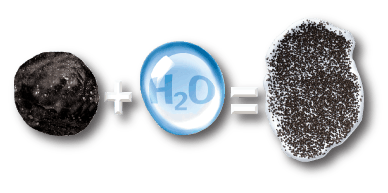
Humic acid is one of the most important components of organic matter. It is an organic bio-stimulant that contains three very important components: Humic Acids, Fulvic Acids and Humin. It has many uses and has become very popular in organic lawn care and organic gardening.
Humic acid is a natural soil conditioner that acts as a microbial stimulator. It has a unique structure which includes a high concentration of trace minerals and organic acids. Humic acid enhances a plant’s ability to take in essential nutrients and improves soil structure. Proven Humic Acid Benefits include:
- Increases soil carbon
- Improves plant health
- Improves germination and viability of seeds
- Chelates macro and micro nutrients to increase availability to the plant for a longer period of time
- Increases cation exchange capacity (CEC)
- Improves soil structure for better aeration and water movement
- Stimulates beneficial microorganisms, which can improve long-term soil pH
- Especially effective on sandy soils
Humic DG
Humic DG is a homogeneous dispersing granule that combines pure, dry humate and humic acid precursor. Humic DG provides all of the proven benefits of humic and fulvic acids in an easy-to-use product. Shortly after watering, these micro sized particles dissolve into the soil, immediately going to work to improve nutrient efficiency and soil conditions. Humic DG is biological, dispersible, spreadable and blendable. Humic DG contains 4 biologically active components; humic acid precursor, fulvic acid, humic acid and humin. These components range from very soluble to completely insoluble in soil, working together to provide the soil with a broad range of biological benefits, from plant available fulvic acids to the insoluble, high nutrient holding capacity of humin.
Humic Acid has become very popular among lawn care experts and enthusiasts. Having researched this for some time I plan to start applying Humic DG to my lawn this spring. More updates to follow. Humic DG can be purchased conveniently on Amazon and is relatively inexpensive.
This video provides a short overview:
PH – Sulfur and Limestone Amendments
Your soil’s pH is constantly changing. Good lawn maintenance practices, including regular irrigation and application of high-nitrogen fertilizers, naturally lower soil pH over time. Soil testing through accurate soil samples reveals your soil’s pH, texture and other qualities. Test results also provide recommendations on the types and amounts of soil amendments your yard and garden need. Sandy soils, for example, take much smaller quantities of amendments than clay soils do, when it comes to changing soil pH.
The best way to test soil pH accurately is through a laboratory test or Soil test kit however, DIY kits are also effective. I’ve used these ones from Luster Leaf with success.

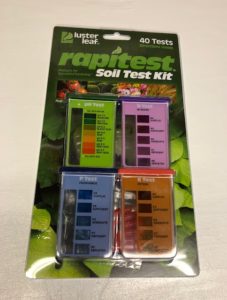
Lime (makes soil less acidic): When lime is used to restore balance to soil pH, lawn grasses and other plants benefit. A source of calcium, lime works to raise soil pH. This is especially important when overly acidic soil (with pH lower than 6.0) interferes with your lawn’s ability to absorb nutrients, including those from fertilizers. Lime starts working as soon as it’s watered in, and raises soil pH quicker than regular lime.Elemental sulfur: When soil pH becomes too alkaline (with pH over 7.5 to 8.0) or when you want to grow your own blueberries or other plants that need low soil pH -such as Azaleas, Camellias, Hydrangeas and Rhododendron, elemental sulfur is often recommended. Mixed into garden soil or applied in a granular form and watered in, sulfur lowers soil pH slowly over time.
Sulfur: Adding sulfur and ground limestone (also referred to as agricultural lime) is much more effective if you can do it before seeding the lawn, or when regrading the site. But you also can incorporate them through aeration as you would compost. It’s recommended to wear a mask to avoid breathing the dust, and long pants and sleeves to avoid a skin rash. Allergic reactions are not common when using these materials, but it’s better to be safe than sorry.
| Raising pH with limestone (lbs. ground limestone per 1,000 sq.ft.) | |||
| Desired change in pH | Sandy soil | Silty soil | Clay soil |
| 4.5 to 6.4 | 50 | 160 | 200 |
| 5.0 to 6.5 | 40 | 130 | 150 |
| 5.5 to 6.5 | 30 | 90 | 100 |
| 6.0 to 6.5 | 15 | 50 | 55 |
| Lowering pH with sulfur (lbs. elemental sulfur per 1,000 sq.ft.) | |||
| Desired change in pH | Sandy soil | Silty soil | Clay soil |
| 8.5 to 6.5 | 45 | 60 | 70 |
| 8.0 to 6.5 | 30 | 35 | 45 |
| 7.5 to 6.5 | 10 | 20 | 25 |
| 7.0 to 6.5 | 3 | 5 | 7 |
Moderation
Soil amendments are meant to improve your soil, but unnecessary amendments can backfire and cause more problems than they solve. Lowering soil pH too much can create toxic conditions. Raising soil pH too high sets off a chain of nutrient imbalance. Even organic matter can cause problems if used too much.
What is the best soil amendment?
This depends on what your soil needs. However, the best all around amendment is organic matter. All soil types benefit from this. Make the most of soil amendments by testing your soil and following the test recommendations. Apply the right soil amendments, in the right quantities, and get the results you desire. Check out my article on soil testing.
Sourcing Quality Amendments
Even with organic matter and the benefits soil amendments bring to the earth, you can put down too much of a good thing. It’s important to know that you can over-do it.
Manure-based composts should be applied at a rate of 1 inch incorporated 6 to 8 inches into soil. Plant-based soil amendments with lower salt levels can be used in greater volume, with an average application rate of 2 to 3 inches worked into a 6- to 8-inch soil depth. With topdressing, you’ll add a thin layer of material on top of turf – about ¼ to ½ inch of topdressing depending on the turf height. Ideally, turf should be aerated before or after topdressing to work compost into the soil.
It’s important to take a measured approach. It’s better to apply small amounts of compost topdressing annually for several years rather than trying to ‘catch up’ quickly by applying a lot. Proper application is critical – moderation is key. Also, you want to be sure to use quality compost. That is one of the biggest challenges that contractors need to be careful about: where you source compost, and make sure it is well composted. If manure is not fully composted, it will release an odor. (If composted right, this is not a problem.) Also, poor-quality compost that is not heated at high temperatures can contain weed seed. “It is possible to do damage with bad-quality compost. Providing this analysis to customers can give them peace of mind that the soil amendments you’ll use on their property aren’t “garbage in,” and will make a healthy, lasting impact on soil quality and plant health (Davis)
Application
Soil amendments may be applied in a number of ways. Some are worked into the soil with a tiller before planting. Others are applied after planting, or periodically during the growing season. Soil testing should be performed prior to applying a soil conditioner to learn more about the composition and structure of the soil. This testing will determine which conditioners will be more appropriate for the available conditions.
Top-Dressing to Improve the Soil in Your Lawn
Top-dressing or adding a thin layer of soil over your lawn, can improve the soil without killing the existing turf. Top-dressing addresses some common lawn problems, including:
- Low spots due to rotting tree roots, settling after underground pipe or cable installation, or erosion.
- Uneven terrain caused by winter freezing and thawing, water runoff, tunneling critters, or general soil settling over time.
- Compacted soil in high-traffic areas or low-lying places where water pools.
- Bare spots from variations in soil texture and nutrients, heat, drought, or other environmental damage.
- Depletion of nutrients due to leaching, neglect, or repeated use of chemical fertilizers.
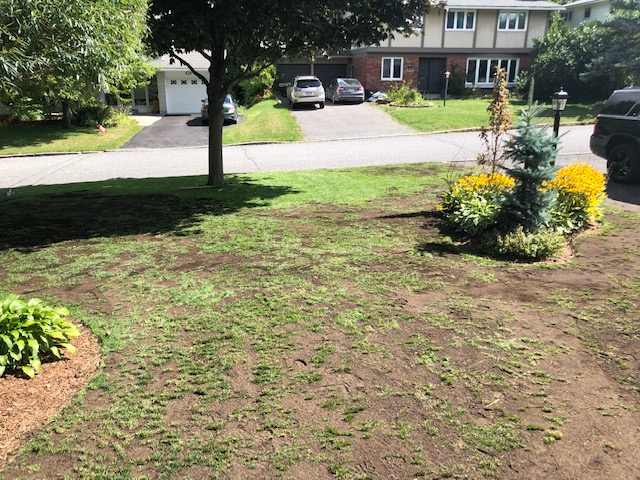
Top-dressing gradually improves soil over time. As organic matter breaks down, it filters through the existing soil to improve texture and overall health. Top-dressing can:
- Improve drainage and drought-resistance
- Even out the terrain
- Reduce the need for supplemental fertilizers
- Transform your lawn into organic, low-maintenance, healthy turf
The material should be of a uniform particle size, or the spreader will clog and distribute unevenly. You can drag the lawn with a piece of chain link fence or a stiff-tined rake to help move the material off the grass blades and into the holes left by the aerator. Whether rebuilt through deep incorporation or gradually via aeration and topdressing, the goal is to improve root development and tolerance to drought or excessively wet soils. The topdressing that works best in my region and for my soil type is a mix of top soil, black peat, and mushroom compost. Check out my article on topdressing for more details on this process.

Environmental concerns
While adding a soil amendment can seem like a great way to get a healthier lawn, over-application of some amendments can cause ecological problems. For example, salts, nitrogen, metals and other nutrients that are present in many soil amendments are not productive when added in excess, and can actually be detrimental to plant health (i.e. fertilizer burn). Runoff of excess nutrients into waterways also occurs, which is harmful to the water quality and through it, the environment.
How to Improve Grass on Clay Soil
Clay soil is heavy and compacts when wet, reducing the amount of oxygen and nutrients available to plants. The result is a sparse lawn with poor drainage.
Aerate the soil. Clay soil needs regular aeration to allow water and oxygen to move freely through it.
Clay soil drains slowly and saturates easily, especially during periods of heavy rain or snow. A lawn drainage system transfers water from one area, through pipes or tiles, to another area, such as a waterway, ditch or man-made bed.
How to Improve Grass with Sandy Soil
Any soil with sand content above 50 percent is considered to be “sandy soil.” Many sandy soils are actually well suited to growing turf grass. Consider Fescue if you have sandy soil (and especially if you live in an area with drought). For those with sandy soils in a warmer climate, Zoysia and Bermuda or grass types that do well with sandy soil.
The best sandy soil amendments are ones that increase the ability of the sandy soil to retain water and increase the nutrients in the soil as well. Sandy soils can usually benefit from the addition of organic material, such as well rotted manure or compost (including grass clippings,composted manure, ground bark or peat moss) which will help the soil to retain both moisture and nutrients. Incorporating 2 inches of organic material into the top 6 inches of the soil before seeding will significantly improve the texture of soils with a high sand content.
Fertilizing Sandy Soils
Turf grass grown in any type of soil will benefit from the regular application of fertilizer, but sandy soils may require even more fertilization to make up for their lack of nutrient-holding ability. In general, you should fertilize new turf once a month with a balanced dry fertilizer at a rate of 1 pound of nitrogen per 1,000 square feet of lawn, so, for example, a 10-10-10 fertilizer should be applied at a rate of 10 pounds per 1,000 square feet. Sandy soils should get an additional pound per 1,000 square feet of nitrogen-only fertilizer in between applications of the balanced fertilizer.
How do you Prepare Soil for Grass?
There is no better time to enhance a lawn’s beauty and success than by improving the soil before any planting takes place. Use the principles above to ensure your soil composition, texture, and profile are optimized.
Benefits of Proper and Complete Soil Preparation
- Improved Uniformity
- Increased Density
- Faster recovery from wear
- Reduced Use of Water, & Fertilizer
- Reduced Maintenance
Adding Sand to Improve Drainage
You might be tempted to add sand to improve the drainage of a heavy soil, but as logical as this sounds, it’s not a good idea. The opposite effect would likely occur. Drainage problems are usually due to a predominance of silt and/or clay, and when combined with sand these soils become harder, not more permeable.
The silt and clay which causes the lawn to drain slowly can only be improved through generous amendment with compost, or by amending the existing soil to bring the sand percentage to 85%. Doing so would mean adding a whole lot of material to the lawn which is usually not practical. Or to replace the existing soil with a sandy mix.
If the lawn remains too wet after remediation attempts fail, consult a contractor about installing a lawn drainage system. The most common type uses perforated pipes, made of various thicknesses of hard plastic–usually PVC. The system collects water and directs it away from the lawn. It is usually desirable to place gravel around the drain tiles to prevent clogging by fine soil particles. At several locations in the wet area (usually 6-8 feet apart), columns of the gravel extend up to the surface of the lawn and function as catch basins for collecting surface runoff water. A perforated cover is placed on top of the columns to discourage soil particles from clogging the system. (Fech)
Conclusion
The knowledge of what’s necessary, the amount and availability of materials and the immediate costs of time and money are the factors that typically deter people from taking the steps necessary to improve their soil. While some people do not fully understand the importance of good soils for grass, many also believe they can save time and money by ignoring the need to improve their lawn’s soil.
Failing to improve the soil before planting is only inviting a much greater and continual investment of both time and money that will never return its value as fully as preparing the soil properly before planting any grass.
If you’re overwhelmed by all of of the elements of improving soil health, start with organic matter. That is the simplest, most universal thing you can do for your soil. Take one step at a time and your lawn will surely thank you. And work towards understanding your soil. This will help you determine the right amendments to create a healthy lawn. Good luck.
Stay tuned for more soil amendment updates! Also, check out my recommended gear section here for all the tools and products I use.

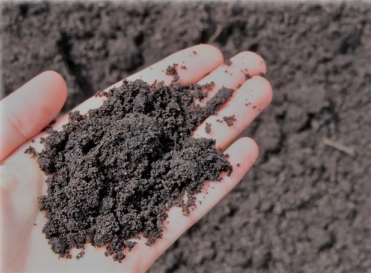
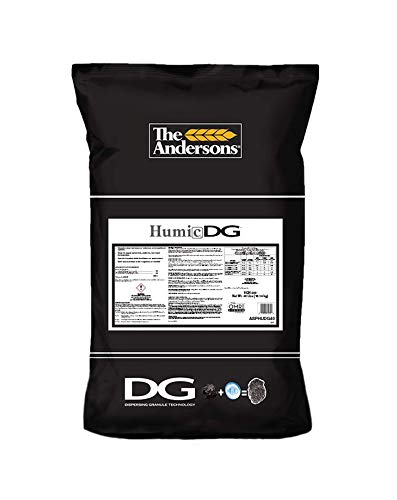
Comments
Lots of information to process.
An A+ article.
Thanks! It’s a big topic for sure.
A wonderful, detailed and easy to understand article – thank you!
This is one of the best articles of read on lawns! I did not know much of anything about the subject before a moved to this location with a depleted soil condition. The more I have tried to find out about grass, grass types, and growing zones the more I realize that the condition of the soil is the most important factor in creating a successful lawn. It is maybe the least talked about also. Lot’s of bad information out there too. I wish someone would write a article on what to do, or not to do for specific soil conditions. My soil is loaded down with phosphorous, but has a deficiency in potassium so it is tricky how to go about adding potash/potassium without also adding more phosphorous.
As so far as I have been able to find out their is no way to lower the phosphorous level in soil. if anyone knows a safe way I would love to chat!